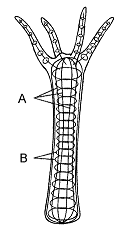Which is characteristic of all vertebrates?
A) a skull and a backbone consisting of vertebrae
B) a calcified (hard) skeleton and four legs
C) a hinged jaw
D) lungs or lung derivatives
Answer: A
You might also like to view...
Radially symmetrical animals have loose meshes of neurons that are called
a. nerve nets. b. brain nets. c. ganglia nets. d. nerve cords. e. cephalization nets.
Contraction of the fibers labeled A in the accompanying figure results in:

a. elongation of the body.
b. elongation of the tentacles.
c. elongation of the gastrovascular cavity.
d. shortening of the body.
e. expansion of the pedal disk.
The energy source for the light reactions is _____; the energy source for the carbon reactions is ______.
A. ATP, carbon dioxide B. sunlight, carbon dioxide C. sunlight, ATP D. ATP, oxygen E. Sunlight serves as the energy source for both sets of photosynthetic reactions.
Cytokinesis in animal cells involves the formation of a/an:
a. oncogene b. cell plate c. cleavage furrow d. sister chromatid